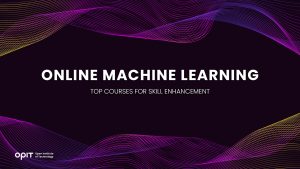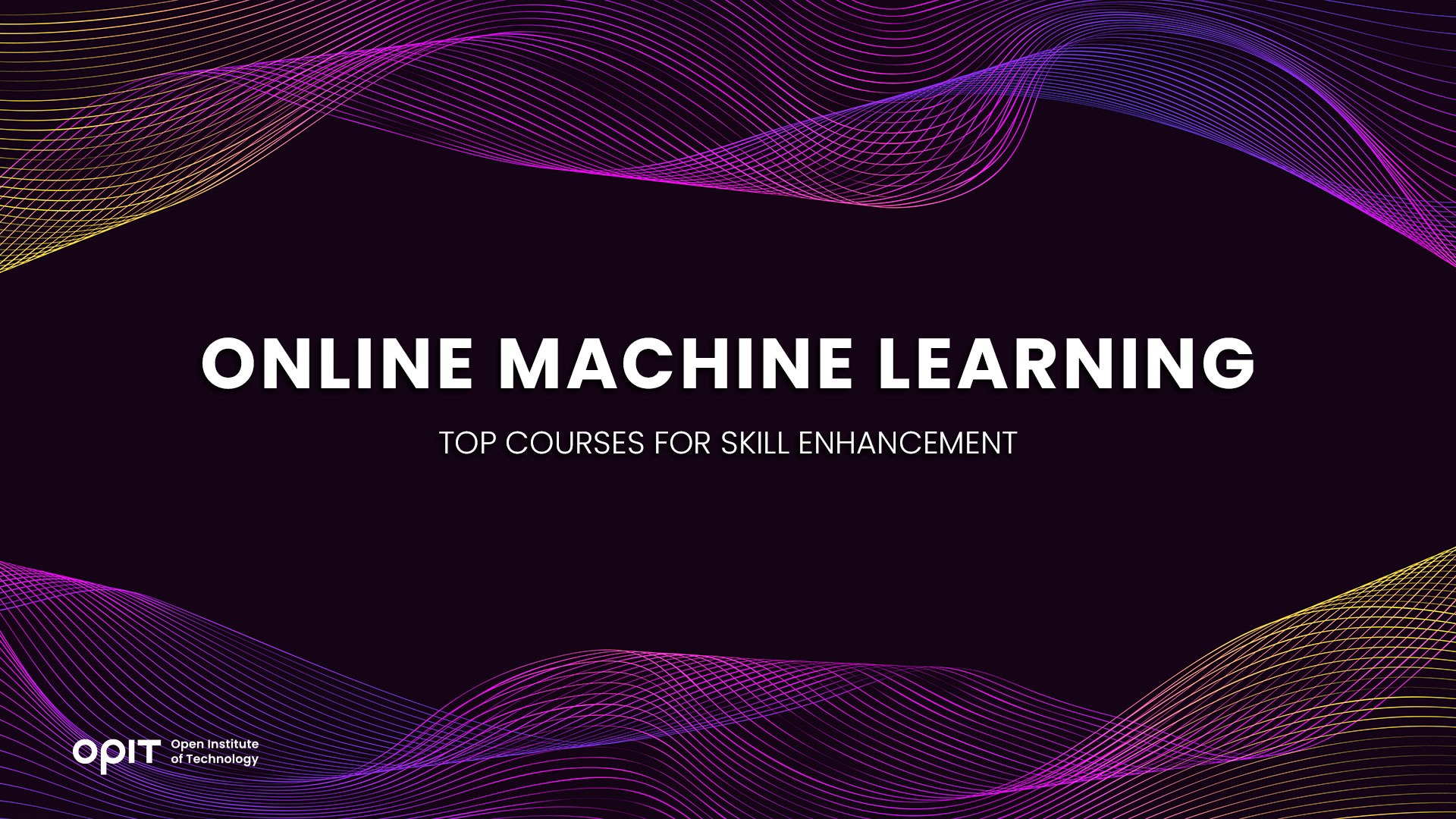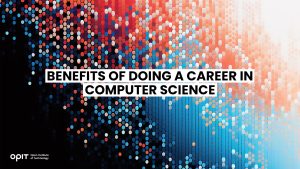

Once a concept found exclusively in science fiction, machine learning has seen widespread use in the modern age. As soon as various industries grasped the potential of ML, this field of computer science turned into a staple of tech and other businesses.
Naturally, all this has led to an increased demand for machine learning experts. The job market abounds with offers for positions in the field, and the competition is fierce. In other words, you may find plenty of job openings for machine learning professionals, but you’ll need to fit the bill to actually land the position.
Fortunately, there are plenty of online machine learning courses to give you the needed expertise and boost your skills. This article will help you find the best machine learning course online and explain the top options in detail.
Factors to Consider When Choosing an Online Machine Learning Course
If you like the idea of online learning, machine learning courses are readily available. In fact, the number of options may be overwhelming. That’s why we’ve applied certain strict criteria when looking for the best machine learning online course. Moving forward, you should also keep those criteria in mind.
Firstly, the content of the course will matter the most. Machine learning is a broad field, and you’ll want to ensure that the education you’re getting is the one you need. Also, every genuine venue of machine learning online training should give you a solid foundation while placing a particular emphasis to specific skills.
The curriculum won’t be the only aspect of the course that matters, though. Who is teaching you will be crucial as well. Ideally, your instructor should be an experienced professional in the field so that they can teach you the theory as well as the practical applications.
Next, one of the primary reasons why you’d want to take a course rather than enroll into a BSc or MSc program is time. You don’t want a course to take up too much of your time, which is why flexibility and the overall duration are essential. You’ll want a well-structured online machine learning course that will leave room for a job or any other activities.
Beside the knowledge provided, hands-on experience will be vital. Once you complete a course, you should be able to apply everything you’ve learned there. To that end, a quality machine learning online course will focus heavily on the real-world application of the skills taught.
Finally, the pricing will play a major role. Similar to time, budgetary concerns are likely a core reason why you’re opting for a course. Simply put, you don’t want it to cost the same as a year at a university. And if the price is somewhat higher, the course should provide plenty of additional resources to justify it.
Top Online Machine Learning Courses
Imperial College Business School – Professional Certificate in Machine Learning and Artificial Intelligence
Course Overview
This program deals with the essential AI and machine learning concepts, teaching you when and how ML solutions can be applied to real-life problems. The course is relatively long, lasting for 25 weeks. It was developed in collaboration with the Imperial College’s Department of Computing.
Key Features
- Taught by experts
- Hands-on activities
- Projects worthy of your portfolio
- Ends with a capstone project
- Verified digital certificate
Pricing and Additional Resources
The price of this course is £3,995, which is reasonable considering its extended duration. During the course, you’ll have individual advisor support for career-building. Completing your studies will also grant you the status of an Associate Alumni, allowing you to join the Imperial College Business School’s community.
Google Digital Garage – Machine Learning Crash Course
Course Overview
If you want to learn machine learning fundamentals quickly and efficiently, this course is just the ticket. It includes comprehensive text and video lectures, practical exercises, and work with the TensorFlow ML library. You’ll gain relevant knowledge and experience through three modules lasting a total of 15 hours.
Key Features
- Lecturers are Google’s researchers
- Intermediate level
- Genuine case studies
- Interactive algorithm showcases
- Fast-paced and applicable
Pricing and Additional Resources
If you’re wondering how much a course from a leading tech giant company may cost, you’ll be pleasantly surprised: This Google machine learning online course is absolutely free. In addition, it’s quite short and very efficient.
IBM (via edX) – Machine Learning With Python: A Practical Introduction
Course Overview
This course teaches you supervised and unsupervised machine learning using Python. An introductory course, it may last up to five weeks. Best of all, the program is entirely self-paced, meaning you can tackle individual lessons at a tempo that suits you. It’s worth noting that this course also explores widely used models and algorithms, supported by actual examples.
Key Features
- Taught by a Senior Data Scientists at IBM
- Part of IBM’s one year certificate program for data science professionals
- Beginner-friendly
- Focus on statistics and data analysis
Pricing and Additional Resources
Like Google’s course, this program by IBM, hosted on edX, is free. It’s worth noting that there’s also a “Verified Track” version, priced on edX at $99. This version of the course will provide unlimited source material access, exams, graded assignments, and a shareable certificate.
DeepLearning.AI (via Coursera) – Unsupervised Learning, Recommenders, Reinforcement Learning
Course Overview
As a part of a specialization in machine learning, this course teaches unsupervised learning as a particular branch of ML. You’ll also learn about recommender systems and how to build certain machine learning models. The course is designed by experienced DeepLearning.AI members in collaboration with Stanford University. You’ll be able to complete it in about 27 hours.
Key Features
- Flexible course scheduling
- Part of a three-course specialization
- Taught by an experienced lecturer and ML professional
- Beginner-friendly
- Teaches specific machine learning techniques
Pricing and Additional Resources
This course, as well as the entire specialization, is available with a Coursera subscription. As a subscriber, you won’t pay any additional fees for the course. Plus, you’ll gain access to a shareable certificate, practice and graded quizzes, and other subscriber benefits.
Microsoft – Foundations of Data Science for Machine Learning
Course Overview
More than a regular course, Foundations of Data Science for Machine Learning is a learning path which consists of 14 modules. It will take you through the entire journey, from the machine learning basics to advanced architecture and data analysis. The course can be completed in under 13 hours.
Key Features
- Offered by a leading tech giant
- Provides lessons and exercises
- Entirely browser-based
- Interactive learning
Pricing and Additional Resources
This training course by Microsoft is free and available immediately. Enrolling in the course comes with no prerequisites.
Tips for Success in Online Machine Learning Courses
Once you choose a machine learning online course, simply signing up for it won’t be enough. You’ll want to ensure you’re getting the most value out of the program. To that end, it would be best to apply the following tips:
- Set your goals and expectations: The best way to get optimal results from a course is to go into it knowing precisely what you want. Clarify what you’re looking to achieve and what you expect the course to provide, and you’ll have an easier time both choosing and completing the program.
- Dedicate time to study and practice: Course lectures will be a vital part of the learning process, but the time and work you put into it will be what makes it all worthwhile. Approach your machine learning online course with the utmost dedication and responsibility, making sure to always set aside the time of day for studying.
- Engage with the community: A learning environment is perfect for building a network. You’ll contact other people with similar interests, which may broaden your viewpoint, provide additional knowledge, and even open up job opportunities. Don’t shy away from online forums or any other type of meeting place that your peers frequent.
- Try out new skills and concepts in real-life: Even if the course you pick involves practical projects, you should be proactive beyond that point. Take what you’ve learned and try to apply it on something outside the course. The best time to start practicing is as soon as you learn a new skill.
- Keep updating your knowledge and skills: Machine learning progresses rapidly, so you’ll have to do your best in keeping your knowledge and skills relevant. A quality course will give you a good foundation. However, updating what you’ve learned will be entirely up to you.
Become a Machine Learning Expert Online
If you’ve found the best machine learning course online for your purposes, you should start learning right away. Armed with the proper skills, you’ll have greater chances of getting work in the industry and starting a career in this science of the future.
Explore which machine learning online course fits you best and start pursuing your goals. You’ll find the knowledge and experience gained as the perfect catalysts for personal and professional growth.
Related posts

Life is unpredictable. While many of us have specific hopes and expectations of how our futures will turn out, things don’t always go as expected. There are many variables and unexpected incidents that can interfere and force you to alter your plans, and this is particularly true when it comes to education.
For instance, you might have had plans to study a specific subject, but had to deviate from those plans due to unforeseen circumstances. Or you may have had to enter the workforce in an occupation different from the one you sought in an effort to earn an income, a move that may not provide you with the time or opportunity to achieve your desired educational aims.
In short, every individual’s career pathway is different, and very few go exactly as we expect from the outset. Fortunately, even if you experience a few false starts or sudden twists in your pathway, there are always options available to help you get back on track.
The Unpredictable Nature of Education
In theory, the educational process seems simple. You select a course of study that interests you from the vast array of subjects and prospective professions, select the appropriate classes, acquire the knowledge and skills you need to succeed, and then embark on your profession.
In reality, however, as many people know from firsthand experience, the road to education is often far from straightforward. Here are just some of the many challenges that can take your educational path in a completely different direction:
- Life’s Curveballs: As touched on in the introduction, life is impossible to predict. Financial hardships, health issues, and family emergencies are just some of the unfortunate occurrences that might derail even the most perfectly planned educational regime.
- Changing Interests: People’s desires and preferences don’t necessarily stay the same throughout their entire lives. As you grow, learn, and have new experiences, your interests may change, and so, too, may your educational objectives.
- Pressure and Burnout: Some academic paths are particularly challenging, demanding intense levels of study and hard work. This can sometimes prove too much to bear, even for the most resilient students.
- Failures and Setbacks: Conventional education largely builds around tests and examinations, requiring students to demonstrate their competencies repeatedly. It’s a system that doesn’t suit everyone, and test failures can lead to setbacks and delays.
- Inequality: People can be born with very different privileges and levels of access to education. Those in certain parts of the world may find it much more challenging to complete their education path for financial, cultural, or even political reasons.
- Late Bloomers: People develop at different paces. Some may struggle educationally early on in their lives, forcing them to make certain concessions or sacrifices related to their studies, only to find their feet later in life once they’ve entered the world of work.
Whether you’re a late bloomer, have had your educational aspirations delayed by personal problems, desire to learn new skills and try something different, or want to begin a fresh chapter in your professional life, the Open Institute of Technology (OPIT) may be able to help.
Introducing OPIT
OPIT is an online teaching platform, making high-level technological educational programs accessible to all, no matter their age or background. Offering education in fields like computer science, artificial intelligence, and digital business, OPIT provides a curated collection of degrees. In addition, they offer classes taught by world-leading tutors imparting the wisdom and skills students need to achieve their goals and become the tech leaders of tomorrow.
Meanwhile, for those who have had somewhat tumultuous or unpredictable educational paths, OPIT offers the perfect course corrector: the OPIT Foundation Year.
The OPIT Foundation Year
OPIT’s Foundation Year is a Pre-Tertiary Certificate in Information Technology, fully aligned with MQF/EQF Level 4 standards and valued at 60 ECTS credits. Lasting just one year, this program essentially serves as a comprehensive yet accessible springboard towards higher-level education, creating a path towards degrees and careers in dynamic, flexible fields, like computer science and digital business.
Like other OPIT programs, the Foundation Year is delivered entirely online via the OPIT Virtual Learning Environment. Combining live lectures, asynchronous content, and interactive assessments, students enjoy diverse and dynamic study experiences, acquiring core skills like academic writing, mathematics, and computer literacy, and building a bedrock of knowledge and confidence before taking their next steps.
Who Is the Foundation Program For?
The Foundation Program is designed to provide a solid base upon which to build the technological education many students need. It’s the perfect choice for those who are eager and ambitious to enter professions in AI, data science, and computing, but don’t feel that they have the necessary core skills and knowledge needed to dive straight into a degree.
Entry requirements are relatively relaxed in order to allow as many students as possible to enjoy the benefits of this program. With that said, applicants should ideally hold an MQF/EQF Level 3 or equivalent qualification, with the intention of pursuing a bachelor’s degree. A minimum of B2 level of English proficiency is also required, as this is the working and studying language of the institution.
What the Foundation Year Provides
Perhaps you’ve recently graduated, are considering a career change, or finally have the opportunity to return to education after initial delays or unexpected disruptions to your original plans. Either way, the Foundation Year can help you enjoy:
- Greater Self-Confidence: Foundation Year graduates gain the fundamental skills they need to enter degree programs with much more self-belief and assuredness.
- Superior Tech Knowledge: Lasting two terms, this course explores mathematics, academic reading and writing, and provides an introduction to computer hardware and software.
- Foundational Mathematics: Mathematics literacy forms a large part of the study focus for the Foundation Year, helping students feel more comfortable with numbers and formulas.
- Flexible Learning: Unlike more rigid, conventional education environments, OPIT gives you the freedom and flexibility to study at a pace that suits you best, all from the comfort of home.
- Global Community: OPIT is an international institution, with staff and students from all around the world eager to share knowledge, exchange ideas, and help one another.
Take Your Next Steps to Success With the OPIT Foundation Year
If you’re curious about a career in technology or have always wanted to work with AI, data, and computers, but struggled to find the time and opportunities you need to acquire relevant skills and knowledge, the Foundation Program was made for people like you.
It’s the ideal entry point into the exciting world of online education, and the perfect first step towards a prestigious degree from an innovative and increasingly successful institution. Download the brochure to learn more about it, or start your online application, today.

Students today have a broader range of fields of study to choose from than ever before, but with the world becoming increasingly technological and computers increasing in influence and importance, pursuing a career in computer science often proves a smart, strategic choice.
There are numerous benefits and career paths associated with studying and working in computer science, and we’ll be listing just a few of them in this guide.
High Average Salaries
With the rising cost of living in many parts of the world, it’s unsurprising that many students are thinking several decades ahead to determine what level of starting salaries they could obtain in different career fields.
Many are also seeking professions that offer the opportunity for growth and the ability to advance up the ranks over time, thus increasing their salary and their quality of life in the process.
If a strong, stable salary with the opportunity for improved income is one of your top career priorities, computer science should be at or near the top of your list of prospective careers.
According to recent data, computer scientists earn an average of over €65,000 per year, with certain jobs, like IT project leader and data scientist, paying ever higher. Starting salaries are strong, too, with graduates earning anywhere from €46,000 to €60,000, depending on their chosen profession and level of qualifications.
There are similarly high average salaries reported around the world in computer science and related fields such as data science and AI/ML engineering. These numbers are projected to increase in the years to come, pointing to computer science as a way for graduates to get off to the best financial start of any career.
Unrivaled Flexibility
A common problem with some subjects and courses is that they only provide graduates with a narrow set of skills and a similarly narrow range of potential professions to which they can apply those skills.
That’s not the case with computer science. Graduates in this field can enjoy instant access to a remarkably diverse array of career opportunities, with even newer opportunities being created all the time as technology evolves and innovations emerge.
A few of the many industries and roles you might choose to enter in the field of computer science include:
- Healthcare: As a software developer, data analyst, or cybersecurity expert
- Finance: As a fintech engineer, blockchain developer, or security analyst
- Media: As a graphics programmer, AI developer, or game developer
- Education: As an analyst, software developer, or machine learning engineer
Guaranteed Opportunities
Some career paths are more limited than others, with relatively low numbers of opportunities, recurring risks of job loss, or difficulty obtaining employment in the first place.
Again, with computer science, this simply isn’t the case. At a time when 75% of companies plan to embrace AI and other technologies by 2027, and businesses of all sizes and industries are now relying on computers more than ever before, computer science graduates can enjoy almost unbeatable job security.
Opportunities will continue to grow for people with good computing knowledge, whether that be in the obvious fields like software and web development, engineering, and AI development, or more niche sectors.
With so many options, you’re effectively guaranteed a long, rewarding career if you put in the necessary time and effort needed to establish a strong foundation of computing skills.
Rapidly Expanding and Evolving Industries
It’s no secret that the world of technology is a dynamic and fast-moving one. In the past 20 years alone, we’ve seen the proliferation of the internet, the rapid advancement of smartphones and wearable devices, the emergence of AI, and so much more.
In the years ahead, engineers and developers will continue to explore the boundaries of modern technology’s powers and potential, driving new innovations and improvements and opening more exciting job opportunities for those already established and experienced in this field.
Getting into computer science now could therefore provide a solid foundation for a career filled with excitement as you uncover and explore new ways of working with computers in fields as diverse as healthcare, finance, education, entertainment, manufacturing, logistics, and beyond.
Start Your Computer Science Career at OPIT
We’ve discussed some of the many benefits associated with careers in computer science, from the high starting salaries to the rapidly growing array of job options available to graduates. By now, you may be eager to follow this particular career path and take advantage of the wealth of opportunities.
If you’re wondering how to start, the Open Institute of Technology (OPIT) may hold the answers you need. As an exclusively online learning platform, specializing in computer science and digital business, and staffed by some of the world’s leading tech experts, OPIT is producing the tech leaders of tomorrow.
Some of the many advantages of learning with OPIT include:
- Accessible and flexible online education that matches your learning style and schedule
- Heavy focus on real-world applications of the skills you acquire
- An international community of like-minded students from around the globe
- A top team of tutors and lecturers from varying fields and industries
- Progressive assessment of skills and understanding – not constant exams
OPIT offers a small, curated selection of courses for those seeking to gain the technological skills and knowledge to succeed in their chosen areas of expertise. That includes a BSc (Hons) in Computer Science – a six-term program, worth 180 ECTS credits.
Numerous IT industry leaders and experts helped develop this fully accredited undergraduate degree, which is online and accessible to all. Like other OPIT courses, it offers a flexible learning program, with progressive assessments, fast-track options, and the opportunity to be part of a growing community of learners and tutors.
If the benefits of doing a career in computer science interest you, download the OPIT BSc in Computer Science brochure or fill out an online application today and take your first step toward a rewarding and fulfilling profession.
Have questions?
Visit our FAQ page or get in touch with us!
Write us at +39 335 576 0263
Get in touch at hello@opit.com
Talk to one of our Study Advisors
We are international
We can speak in:


